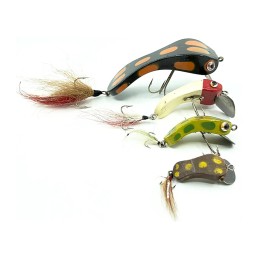The Catch-All
SHARE THIS POST
Being from Wisconsin, I have a soft spot for collecting Wisconsin fishing lures. Wisconsin has a strong and diverse history in the fishing tackle industry. One of my personal favorites is a different-looking lure shaped a little like a shoehorn with a very short history attached to it. It’s called the Catch-All. This wooden, shoehorn-shaped lure has a small metal lip inserted in the front. The lip is adjustable and can be fished in a “spoon up” or “spoon down” position allowing it to dive deeper or just below the surface. The lip is marked “Pat Pend,” although I am not sure a patent was ever applied for or granted.
Old Hiles schoolhouse
Catch-All, Inc., with their official and sales headquarters in Milwaukee, set up production in an old Hiles schoolhouse rented from the Town of Hiles, beginning in January of 1955. The company was started by Clarence “Bud” Granrath. Granrath was already known for his handmade, wooden floater-diver fishing plug and was somewhat of a local legend. Local lore says he was banned from using his Catch-All bait in fishing tournaments as he would catch too many bass on it, giving him an unfair advantage over his competition.
Catch-All quickly got up to production and started to manufacture baits in four sizes and at least six colors. They distributed the baits out of their Milwaukee location at 2028 N. Third St., Milwaukee, Wisconsin.
Here is where the short history of this company gets interesting. In conflicting reports, they either stayed open just a few months in 1955 and produced about 5,000 baits, or stayed open until mid-1957, producing around 50,000 baits. We may never know the exact truth, but given the number of lures in the collector market, the truth may lie somewhere in between. Additionally, after they closed, the old schoolhouse was pilfered for over a decade as leftover inventory lure bodies were taken and assembled in a variety of ways. These lures made it into in the market and provided some unique variations.
Ultimately, the bait wasn’t destined to be a long-term success. At the time, wooden fishing lures were facing stiff competition from newer plastic baits in the industry. Industry giants like Heddon and Creek Chub were hitting their stride on new plastics which offered lower costs, superior paint finishes and better quality control. This made it difficult for any wooden bait to compete in the market, much less a small new entrant.
Sizes and colors
The baits came packaged in a plastic-topped cardboard box. These boxes were white with a red spider web design (see photo) that covered the entire box. The company only produced the one lure design in four sizes. (Note: Quality control makes these sizes estimations, as they do vary a little lure by lure.)
The Catch-All sizes were:
Flyrod – #100 – 1 3/4”
Spinning – #200 – 2 1/4”
Regular – #300 – 2 5/8”
Muskie – #400 – 4 1/2”
The Flyrod and Muskie sizes are the most difficult to find. The Muskie is the rarest by far. This lure did not prove to be very popular with most muskie fisherman since the hooks had a reputation for pulling out when a large fish was hooked.
Are you enjoying this post?
You can be among the first to get the latest info on where to go, what to use and how to use it!
The “catalogued” color patterns were:
Green Frog – #0
Red / White – #1
Black – #2
Yellow Frog – #3
Black / Orange – #4
Scale Pattern – #5
Note that there is an additional color: Brown with Yellow Spots. I have named this color #6 and it is found by collectors quite often. A seventh, uncatalogued color of brown with yellow spots has been found on some models.
It should also be noted that quality control is somewhat of an issue with these baits, especially on paint color. When the company reordered paint, they got a slightly different shade or tone. Consequently, some yellows are more of a lime color and there are two different greens. The yellow/brown scale pattern is the toughest color to find.
Of special note is the display case pictured on the box insert. It holds all twelve lures. To my knowledge, one has never been located, but it would make a fantastic addition to a collection.
Collector’s value
The Catch-All is a tough lure to place a value on as not many exist, but there are fewer collectors of the bait. Most collectors live in Wisconsin or the Midwest. As with most collectibles, it comes down to condition and rarity. This is a lure that doesn’t hold up well to being fished. Additionally, there are a lot of the aforementioned “pilfered” lures that generally aren’t complete and have reduced value. In the three smaller sizes, a Catch-All lure in excellent condition with the matching box and insert paperwork is worth something in the $25 to $40 range. For a Muskie size Catch-All in the same condition, you might expect $100 to $200, depending on the color.
MWO
SHARE THIS POST
You may also like...
Nothing found.
Did you enjoy this post?
You can be among the first to get the latest info on where to go, what to use and how to use it!
